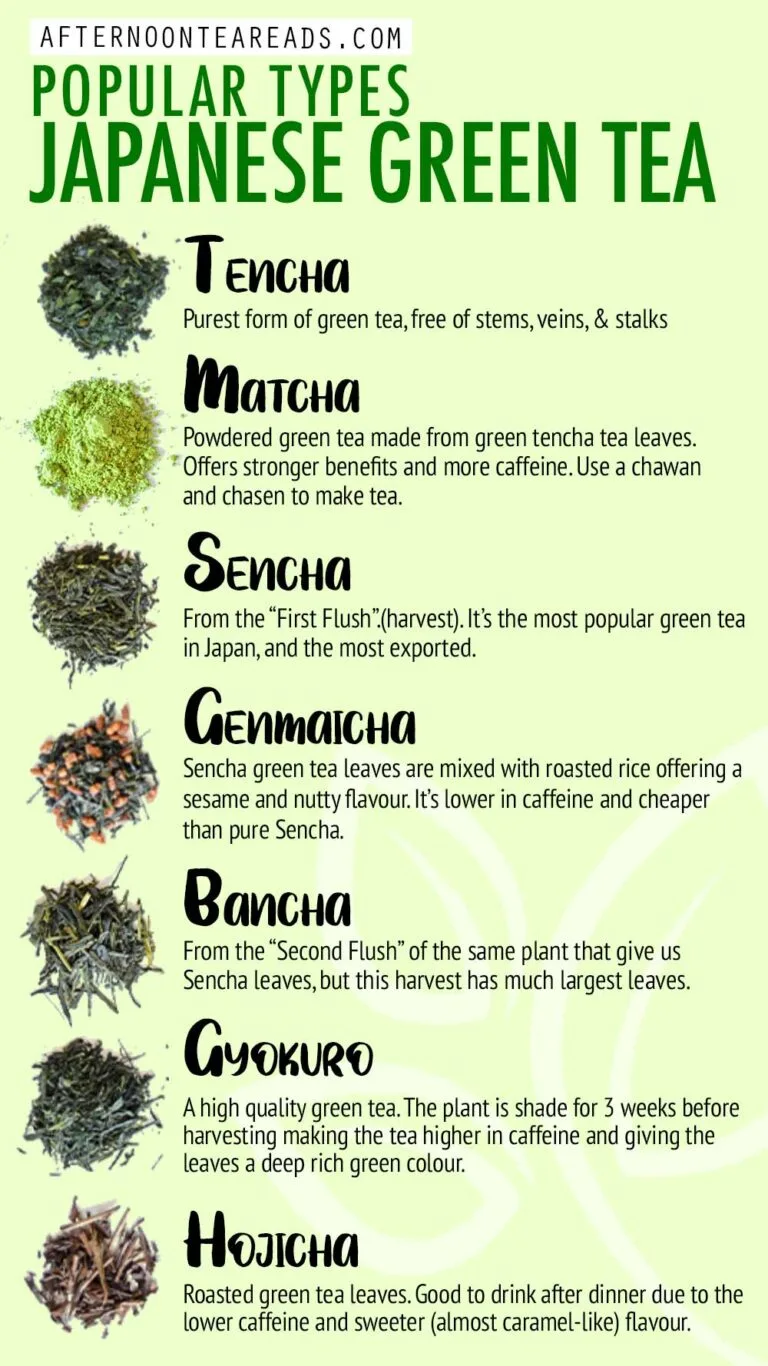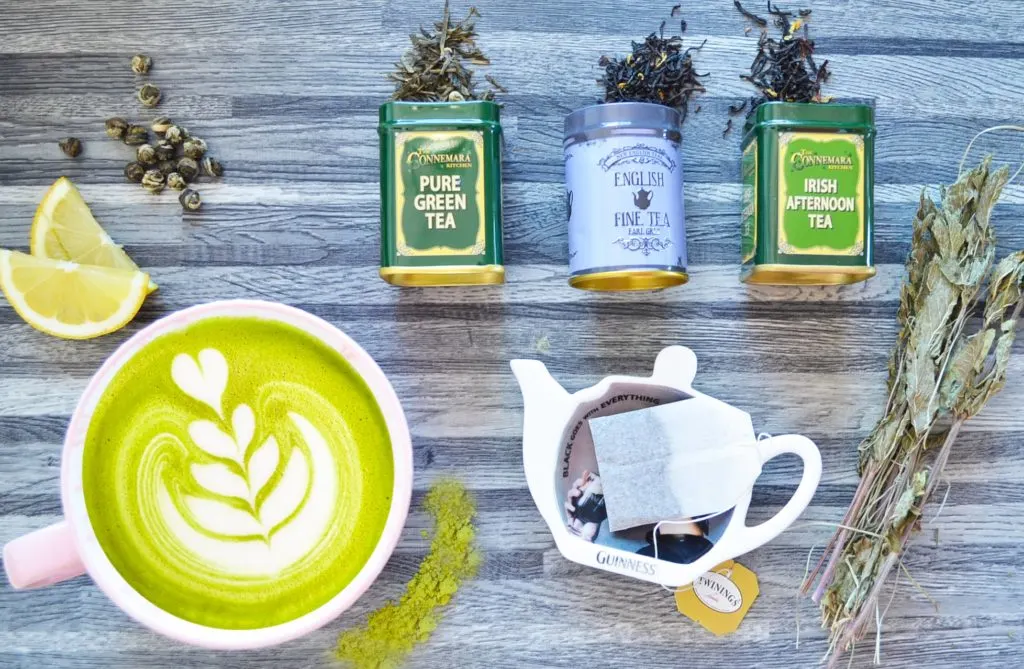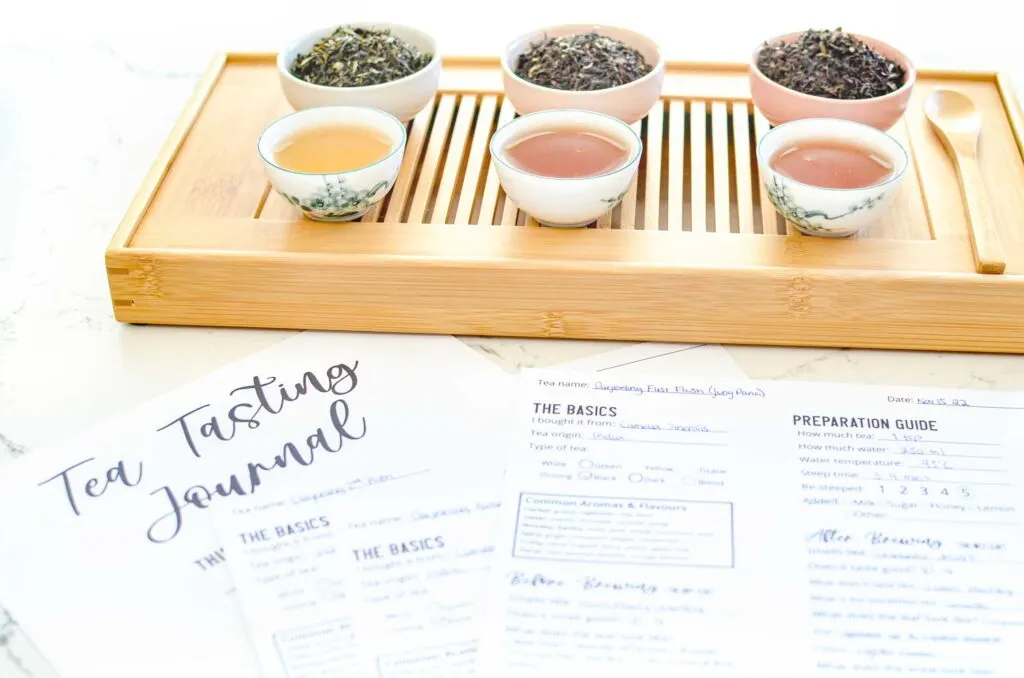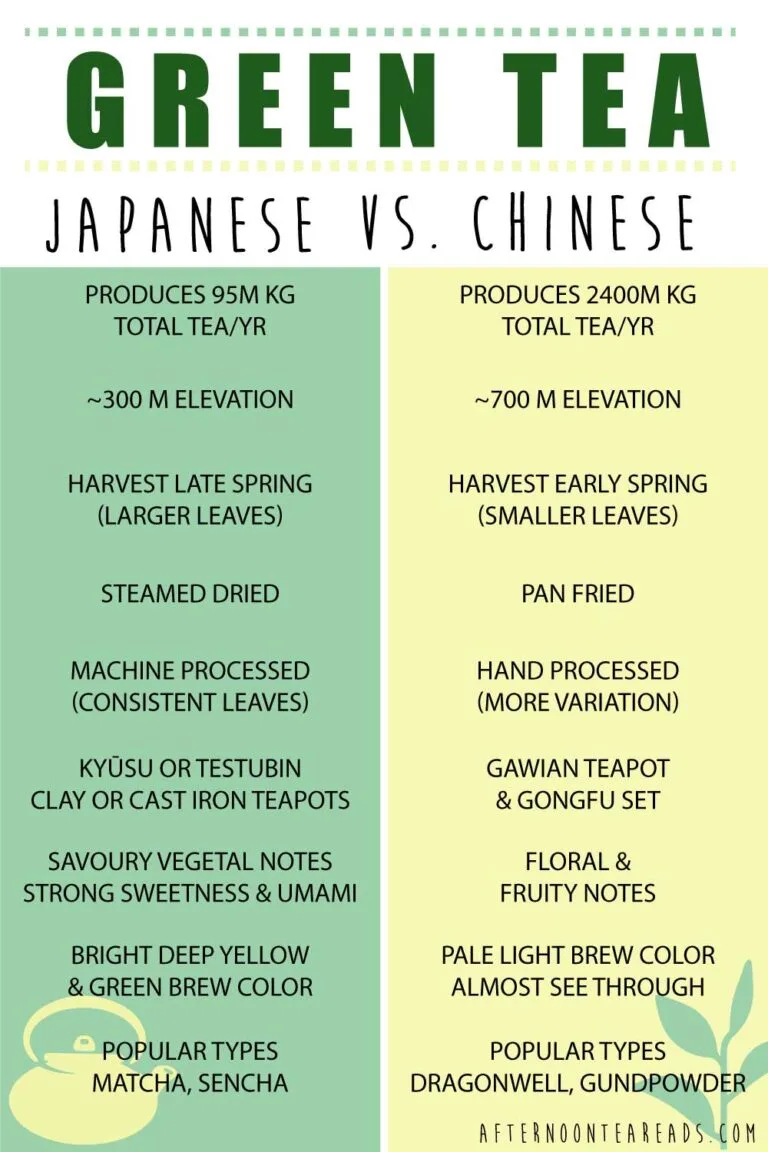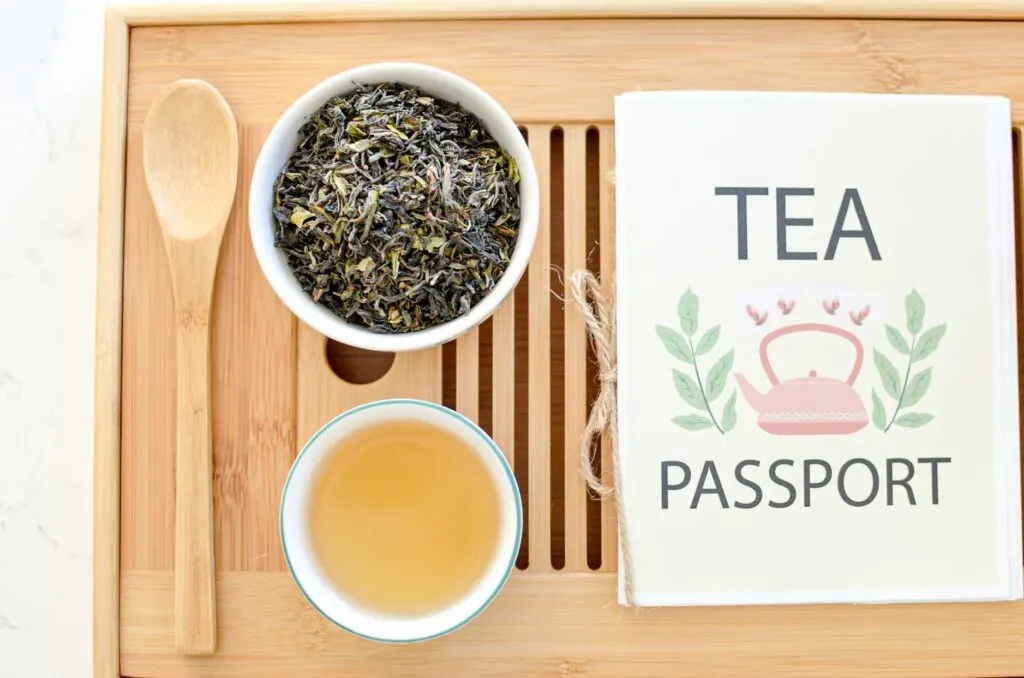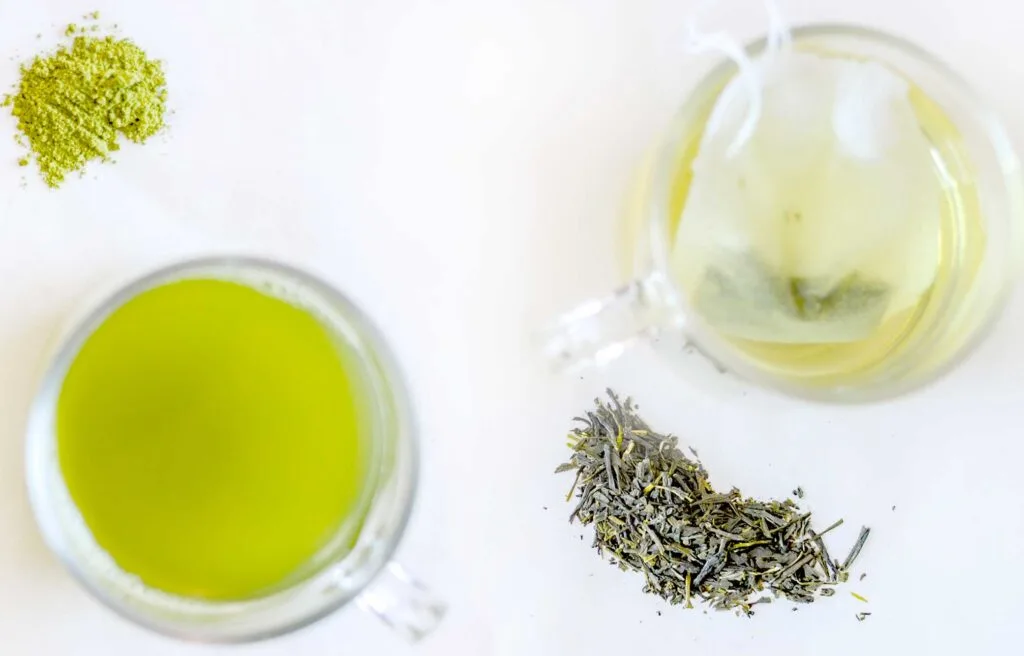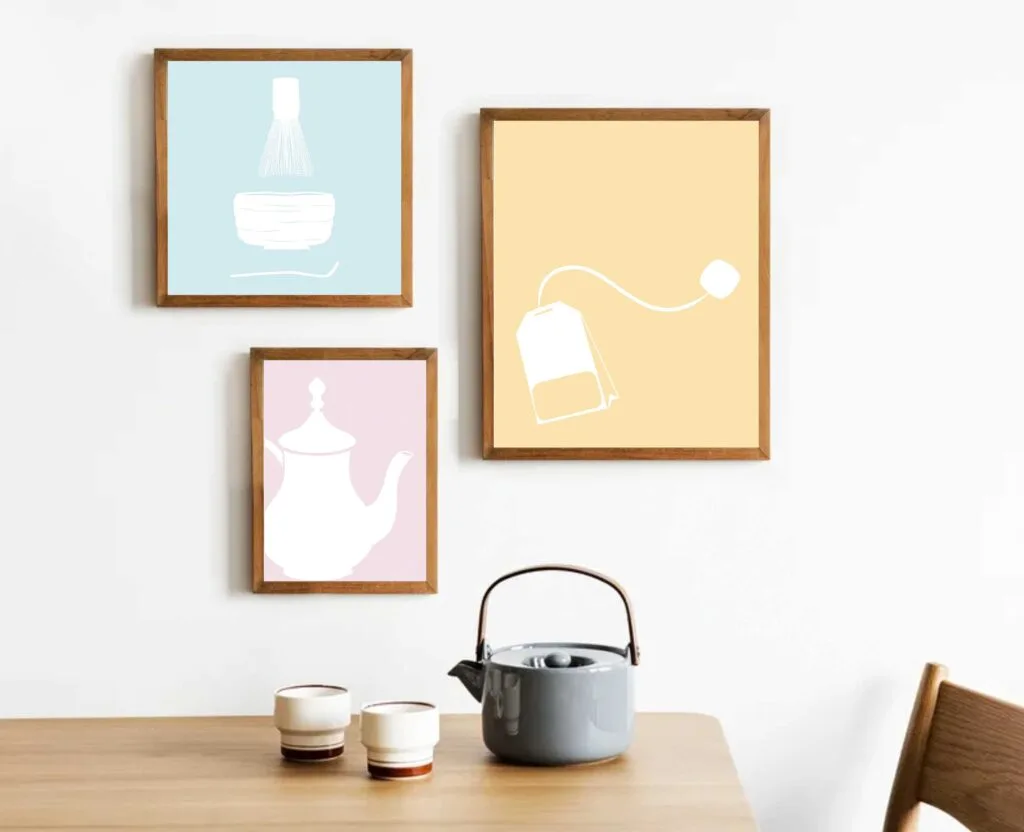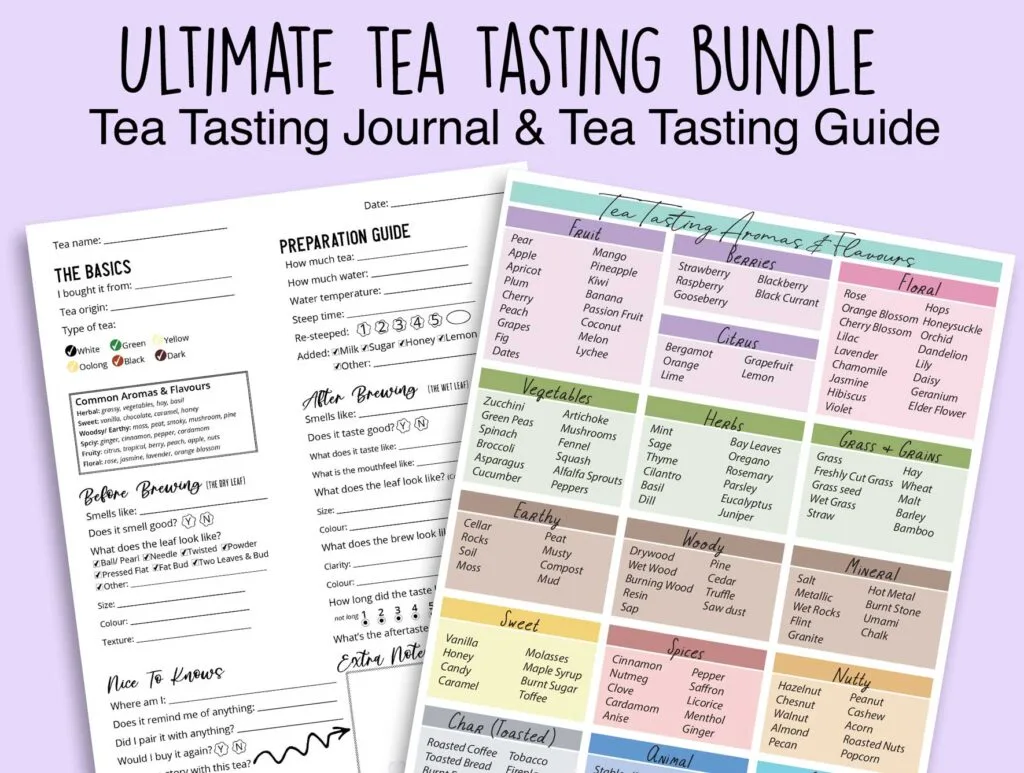Japan produces some of the sweetest and, in my opinion, some of the best green tea in the world. Japan doesn’t just produce one type, but up to 20 different types of Japanese green tea.
The variations come from the age, and different processes the leaves go through before and after harvesting. This allows for a change in taste, colour, and even caffeine levels.
Here’s the ultimate guide to types of Japanese green tea!
Psst! This post contains affiliate links. That means if you buy something through my link, it sends a bit extra my way, at no extra cost to you!
Don’t Have Time Now? Pin It For Later!
What You’ll Need to Enjoy Japanese Green Tea
A Temperature Controlled Kettle: theBay.com | Macy’s.com
A Traditional Kyüsu: Amazon.com | Amazon.ca
A Cast Iron Teapot: Amazon.com | Amazon.ca
A Japanese Tea Set: Amazon.com | Amazon.ca
Tea Tasting Journal: Afternoon Tea Reads – The Shoppe
Other tea posts you might be interested in…
Sakuraco Japanese Subscription Box Honest Review | 11 Best Tea Books Every Tea Lover Needs In Their Tea Book Collection

Understanding Green Tea
Green tea is among the five teas that come from the Camelia sinensis plant (along with black, oolong, white, and yellow). The differences between each tea is how old the leaves are and which out of the 5 processes they go through.
Green tea leaves are the youngest and they go through 4 of the 5 processes to become tea. Plucking, fixing (instead of withering) rolling, drying, and finally they’re sorted. The main difference between green tea and the others types of tea is that they are NOT oxidized.
Because they aren’t oxidized, they also have the shortest shelf life, lasting 6-8 months. This also means they’re typically lower in caffeine compared to black tea and have more vegetal flavours.
You might also be interested in reading…

A History Of Japanese Green Tea
Japan’s main tea export is green tea (around 75% of their total tea), but yet they only make up 1.09% of the world’s green tea.
Tea in Japan has existed since 800 CE, when buddhist monks brought Camelia sinensis seeds over from China. Japanese green tea ceremonies (chanoyu) started around the 12th century. It became about spirituality and a way to find zen and balance.
But it was only in the 16th century that Japan started shading the plant, resulting in today’s gyokuro and matcha. And it was even later that steaming, a defining characteristic of Japanese green teas, was invented by Sohen Nagatani in 1738. This is when they stopped pan firing their leaves as they had learned from China.
Steaming brought out those bright colours and vegetal flavours, giving us the most popular and the best Japanese green teas of all; Sencha.

Chinese Vs. Japanese Green Tea: What’s The Difference?
China produces A LOT more tea than Japan, which means they also produce a lot more green tea. There are also several varieties of Chinese green tea, but they still stand out from Japanese green tea.
Even though Japanese green tea started because it was brought over from China, over the centuries, they could not be less alike. Right off the bat, China and Japan have vastly different terroirs (the terrain which the plant grows) that affects the flavours of the tea.
Japan has a lower elevation which means less harsh weather but also less protection against nasty insects. Because of that, Japan will spend more time taking care of the plant itself (also adding shade, cutting the leaves …etc.) and even afterwards uses machines to process the leaves.
China, on the other hand, leaves the plants and leaves primarily alone. This adds more variation, you will not get the same leaf and brew each time necessarily. Of course, there are always exceptions to the rule.
Build & Track Your Tea Journey
Refine your tea palette with my Tea Tasting Journal to record and take notes on every new tea you try.
The processes to stop the teas oxidizing are also quite different. China more commonly uses pan firing (using either a basket or metal drum) whereas Japanese green teas are steamed.
By changing the processes, you end up with very different teas. Japanese green teas tend to be deeper in color, sweeter, and offer more savoury and vegetal notes.
Chinese green teas are a lot lighter in color, looking more like an oolong. Due to the pan firing, they can also have an earthier, more roasted flavor. But Chinese green teas tend to be more floral and fruity as well.
Popular Chinese green teas include Gunpowder and Dragon Well teas.
Because China produces a lot more tea, there are more likely to be a lot more lower quality teas so you have to watch out. This also means that you will also be able to find some really unique and rare finds in China.

Understanding The Flavours Of Japanese Green Tea
As I mentioned, Japanese green tea is known for its sweeter flavour profile. Of course, each type of Japanese green tea is a quite different. Some are sweeter than others, but it’s all about balancing umami, sweetness, astringency, and bitterness.
The sweetness and bitterness of a tea is more or less obvious to taste. If we compare it to chocolate, milk chocolate is sweet whereas dark chocolate bitter. But what about the other two flavours, umami and astringency?
Taste Tea Where You Are!
Taste tea on the go with my pocket size tea tasting log book on Etsy.
This printable digital download tea tasting journal also comes with a tea tasting guide inside.
Umami, Astringency… What’s That?
Let’s start with umami. Umami is the 5th taste, commonly compared to savouriness. It’s somewhere between sweet and savoury. Soy sauce is a good example of something that is umami. It deepens flavours and makes it more complex.
Sweetness and umami both come from the presence of L-theanine and glutamate. These are due to the leaves being young and even shade grown. They don’t need to develop catechins (which add to the bitterness and astringency).
Astringency comes from the presence of catechins which develop in the sun. Astringency is linked to the dry mouth feel of some teas (it’s also found in some red wines). Green tea is a lot less astringent than black teas.
Depending on what type of Japanese green tea you get, it will have a different amount of each. Typically, higher quality teas are high in umami and sweetness and low in astringency and bitterness.
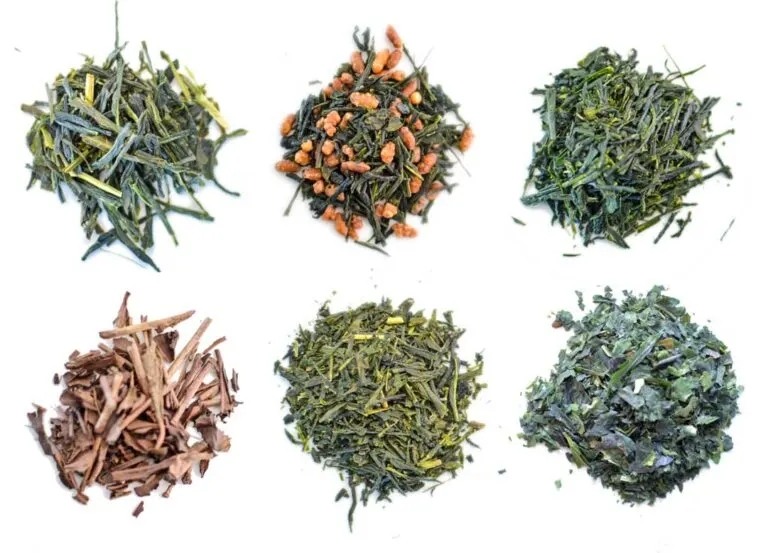
Japanese Green Tea Terms To Know
Before getting into the different types of Japanese green tea, there are a few common terms to know.
Ichibancha (番茶), Nibancha (番茶), Sanbancha, refers to the first flush, second, and third flush, respectively. The first, second, or third ‘flush’ is when they’re harvesting the leaves from the Camellia sinensis plant. Ichibancha is also known as Shincha (新茶), they are used interchangeably (but don’t confuse it with Sencha, which is a type of Japanese green tea).
In Japan, the first flush usually happens in early or late spring, depending on the region. To harvest, they want what’s called Isshin Goyo (芯五葉). This translates to one bud and five leaves, and that’s exactly what they’re looking for.
On the tea plant they want one bud at the top of the stem with five leaves below it. Once they see that, it’s time for the first flush!
The first flush is a big deal for Japanese green tea. It’s the tea leaves with the most nutrients because the plant has been storing them since the fall. Sencha, Matcha, and Gyokuro are examples of first flush (Ichibancha) teas.
You might also be interested in reading…
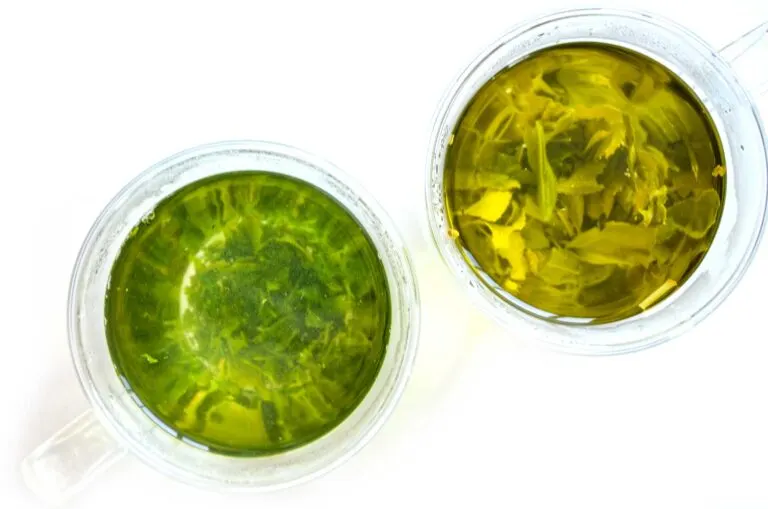
The Different Types Of Green Tea In Japan
There are so many different types of Japanese green tea with a wide array of variety. I’m talking over 20 types of Japanese Green Teas.
The different types vary based on regions, elevation, when they’re harvested, if they’re shade grown, how they’re processed…etc.
These variations result in different health benefits, taste, caffeine levels, and more.
It’s hard to go over all of them, so here are the most popular, unique, and in my mind worthwhile to try.
The most popular types of Japanese green tea include Sencha, Tencha, Matcha, Genmaicha, Bancha, Gyokuro, and Hojicha. Continue reading for a more in depth guide to the most popular types of Japanese green tea.
Full List: Japanese Green Tea Types
- Tencha: Stemless, veinless leaves
- Sencha: First flush tea
- Asamushicha: Lightly steamed, light flavour, light color
- Chuumushicha: Medium steamed
- Fukamushicha: Deep steamed, intense green color, strong flavour
- Benifuki: Sencha with special benefits
- Genmaicha: Sencha with roasted brown rice
- Bancha: Second flush of Sencha leaves
- Gyokuro: Shade grown 3 weeks before harvest
- Hojicha: Roasted green tea leaves
- Matcha: Powdered green tea leaves
- Konacha: Tea rejects (dust and particles). Mainly served at restaurants.
- Kabusecha: Shade grown two weeks before harvest
- Kukicha: Stems and stalks
- Kokeicha: Tea paste turned leaves
- Tamaryokucha: Curly leaves. Can be steamed or pan fired
- Guricha: Steamed, very uncommon
- Kamairicha: Pan fried, common in Western region of Japan
- Mecha: Tea tips and buds
- Aracha: Unrefined tea
Sencha 煎茶
Sencha is the most popular tea in Japan, making up 70% of tea consumption. It’s also their most popular export. Sencha is made from the youngest leaves, it is a first flush tea, giving us the most nutrients.
Unlike the other first flush teas (matcha and Gyokuro) it is a sun grown tea. The smell when not brewed is very fresh and vegetal, it’s thin and long leaves resemble dried grass! When Sencha is brewed, you get a nice deep yellow colour and the smell is beyond refreshing! It’s smooth texture and sweeter taste make this a perfect green tea to enjoy!
Shop Sencha on Amazon
- ORGANIC SENCHA TEA | IMPORTED FROM JAPAN – 4oz/113g Resealable Bag
- SMILE SIP & FEEL GOOD – Brew 50 cups of tea with this premium loose leaf variety!
- LOOSE LEAF TEA – Our loose, organic tea allows you to customize each cup according to your sipping preference. No unecssary waste from bags or…
Bancha (番茶)
Bancha comes from the same plants that gave us Sencha, although it’s now the second flush (Nibancha). The leaves are much larger because it’s the ones that weren’t plucked for Sencha. It comes in long rolled strips to resemble a pointed needle.
Their length makes them just a bit hard to measure because they don’t really fit into a teaspoon nicely. But, Bancha is one my favourite types of Japanese green tea to steep because the transformation from dried to steeped leaf is incredible! The leaf opens up entirely to now look like a full leaf.
The color is a shocking yellow hue when steeped. I find it has a rich taste and full bodied mouthfeel, somewhere between Sencha and Gyokuro (coming up next!).
Shop Bancha on Amazon
- Our quality Japanese Bancha is from Tuzuki-gun, Ujitawara in Kyoto prefecture.
- Bancha is a beloved Japanese green tea favorite. It is tea harvested after the first picking in the springtime for Sencha, this second harvest starts…
- . Bancha produces a gentle cup of green tea that is less fragrant and slightly more astringent than younger Sencha. Its flavor is fine, light, and…
Gyokuro (玉露)
Gyokuro is a very interesting type of Japanese green tea. It’s meant to be a very high quality and can be on the pricier side of Japanese green teas. The plant is shade grown for at least three weeks before harvesting, and is a part of the first flush (Ichiban) in Japan.
The shade grown leaves are very different from most other green teas. You get a very rich, deep green color when steeped. When the leaves open up, they’re not full like Bancha leaves but look like ripped up pieces.
Because they’re shade grown it also allows for L-Theanine to develop so they’re actually higher in caffeine than most other types of Japanese green teas.
The Gyokuro I tasted must have been a blend because it did not taste as I expected (it was also cheaper most Gyokuros). It was definitely more bitter than what I was used to tasting from Japan, but it was still vegetal and grassy.
Although, Gyokuro is known as a very high end Japanese green tea, this was far from my favourite.
Shop Gyokuro on Amazon
- Our Gyokuru Kokyu is a well-rounded tea with a slight grassy flavor in the first notes, rich umami sweetness, and lingering finish.
- This premium tea blend consists of two of Kyoto Prefecture’s finest
- High level of antioxidants; very healthy tea
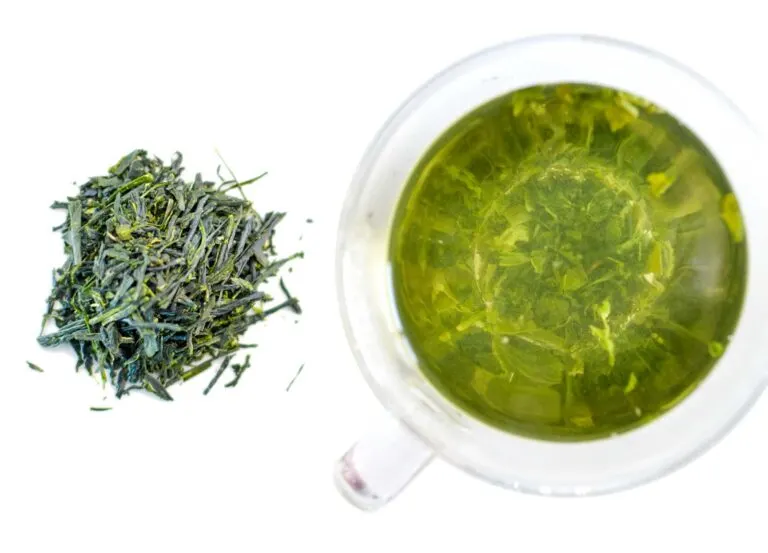
Genmaicha (玄米茶)
Genmaicha might look a bit odd. It’s actually green tea leaves (usually Sencha) mixed with roasted brown rice, and sometimes even popcorn.
Genmaicha was originally made to make tea more affordable in Japan, and lower in caffeine. That’s because you need a lot less tea leaves to steep this tea, and you can also use a lower grade tea as the taste is offset by the rice.
Genmaicha is like no other green tea you’ve tasted before. It has a wonderful nutty and sesame smell and flavour. Sometimes you forget you’re even drinking green tea!
Shop Genmaicha on Amazon
- The exceptional top tier Gyokuro Imperial is intuitively paired with toasted brown rice resulting in a highly aromatic medium bodied green tea blend.
- The taste is pleasant with a hint of nutty roasted rice and a mild aftertaste.
- This aromatic blended tea brings together the refreshing lightness, sweetness and the distinctive taste of roasted rice.
Hojicha (焙じ茶)
Hojicha is a bit deceiving. The look isn’t the most appealing, reminding me of dried tree bark, and not like tea at all. It also smells awful.
But, it doesn’t taste like it smells (or looks), so give it a chance.
Hojicha directly translates to roasted green tea leaves, and that’s exactly what it is.
Once the leaves are steeped, they open up to reveal a beautiful colour and delicious sweet caramel notes. It is now my new favourite green tea! It’s very similar to Genmaicha, but even more subtle toasted notes.
It’s perfect to drink after dinner as well because it has lower caffeine levels.
Shop Hojicha on Amazon
- Originally created in Kyoto about a hundred years ago, hojicha is a unique Japanese tea.
- It is roasted at high heat in a porcelain pot over charcoal, instead of steamed like most other Japanese teas.
- Its mild flavor makes this brew incredibly complimentary, hojicha truly is a wonderful tea for anytime of the day.
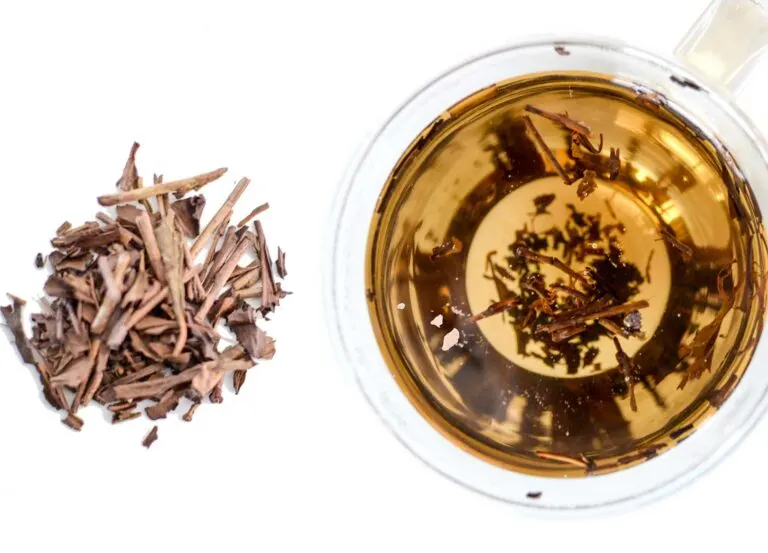
Tencha (碾茶)
Tencha is the purest leaf you could use for green tea. To get Tencha, you have to shade grow the plant and then remove the stems, veins and stalks. If you wanted, you could continue to grind what’s left into a powder, then you’d get matcha (more on that in a bit).
Similar to Matcha, Tencha isn’t exactly cheap (of course there are different grades of each you could find). This was the most expensive tea I’ve ever tried, but honestly, it was worth it. I was shocked by the color of the brew. The leaves are a beautiful bright green, but the brew is had a bit of yellow tint to it.
Minimalist Tea Wall Art For Your Home
Decorate your home with printable minimalist tea art. Wall art digital downloads that you frame yourself include 10 prints of different styles of tea.
This was the sweetest most enjoyable green tea I’ve ever tried. Don’t take my word for it, but I found it had an almost Jolly Ranch taste to it, that’s how sweet it was. The mouthfeel was always very enjoyable, as it was thicker. Although the smell wasn’t strong at all. Because of it’s higher price point, this isn’t your everyday tea. I’d set it aside for weekends, and take time to make a pot and enjoy it. You won’t regret it!
- AN ELEGANT LEAF: Organic Tencha with Matcha is a powerful and smooth green tea to help calm the mind.
- A RICH BLEND: Our unique blend of organic tencha leaves and matcha powder creates a surprisingly smooth and powerful green tea blend.
- THE POWER OF PREMIUM: Tencha leaves deliver a rich source of antioxidants and L-theanine to support mental clarity and increased energy.
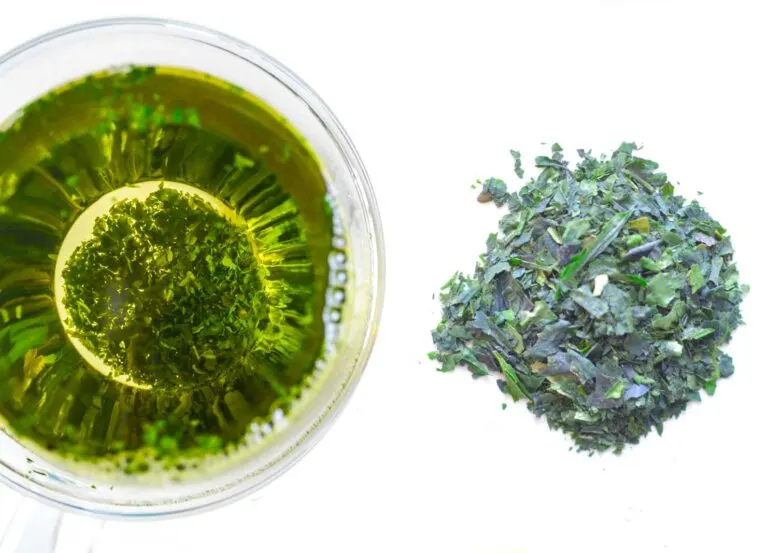
Matcha (抹茶)
If you decide not to leave the leaves for Tencha, as I mentioned, you can grind them into a powder. This gives you matcha. Matcha has been enjoyed in Japan for centuries in Japanese tea ceremonies.
The brew is very different because you have to use a bamboo whisk (chawan) and bowl (chaisen) to make it.
As with most types of Japanese green teas, there are several different qualities of Matcha. Read more about the basics of matcha, or go more in depth about the differences between matcha and green tea, or the differences between culinary and ceremonial matcha.
Shop Matcha Essentials on Amazon
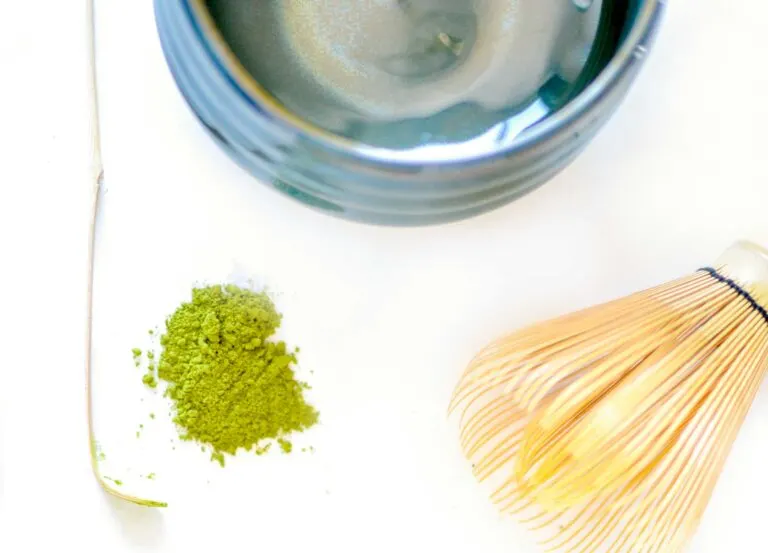
How To Enjoy Japanese Green Tea?
The most traditional way to drink Japanese green tea is to make matcha as part of a chanoyu (tea ceremony). They would primarily enjoy matcha in tea huts (Chashitsu). If you aren’t enjoying matcha, you can steep your Japanese green tea in a normal tea pot though. Or, you can also invest in a more traditional Japanese teapot.
This can either be a Kyūsu, a clay teapot, or tetsubin, a cast iron teapot. Originally, the cast iron teapot was only used for boiling water, but over the years it’s been used to steep tea as well. It’s perfect for keeping your tea as hot as possible!
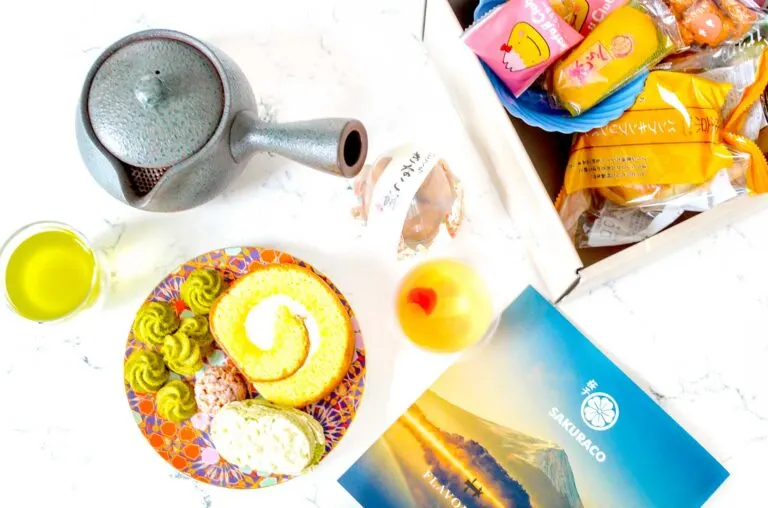
Did you know Japan also has an afternoon tea tradition?
Sakuraco invites you to take part in this tradition at home by sending you tea and traditional Japanese snacks!
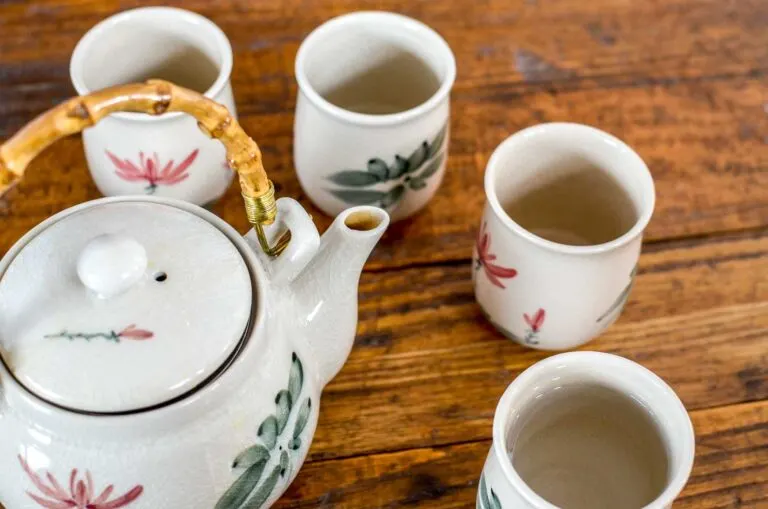
A Kyūsu is basically a teapot, although sometimes you’ll see the handle on the side of the spout. It also has the mesh lining the teapot to automatically strain your tea when pouring. Typically, you want to steep your tea in a teapot and pour in into a smaller tea cup. This allows you to enjoy each sip, and the tea to cool off faster than it would in a huge mug. Because your tea is staying hot in the pot, you’re always drinking piping hot tea!
As I mentioned, Matcha isn’t steeped in a teapot and is a part of a larger tea ceremony. Read more about how to prepare matcha! Plus, if you really want to experiment with matcha, see my 5 favourites ways to drink it in the summer!
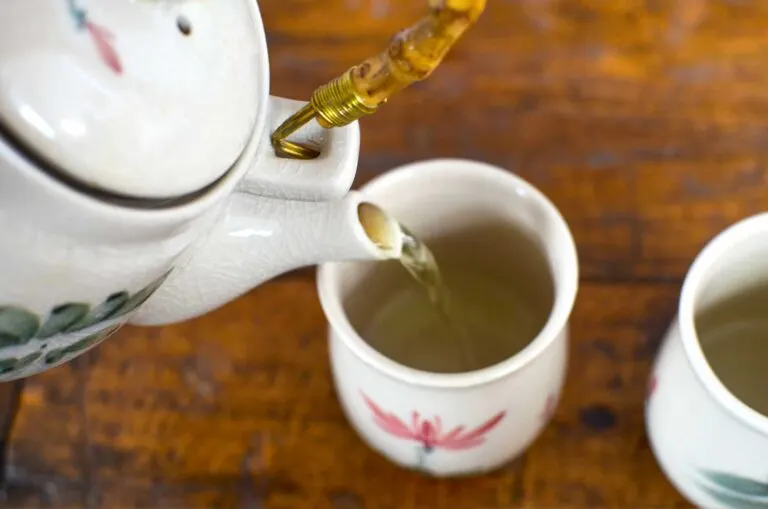
Interested In Tea Tasting? Get The Tea Tasting Bundle!
Refine your tea palette with my Tea Tasting Guide and take notes on every new tea you try to remember for next time in my Tea Tasting Journal.
More Tea Related Pots
- Bring A Taste of Japan Back Home: The Sakuraco Subscription Box Review
- Go Back To The Tea Basics: The Different Types of Teas Explained
- Matcha Vs. Green Tea: Is There A Difference?
- 5 Iced Matcha Recipes Perfect For Summer
- What’s The Best Earl Grey Tea?
Sharing Is Caring
Last update on 2024-04-24 / Affiliate links / Images from Amazon Product Advertising API

